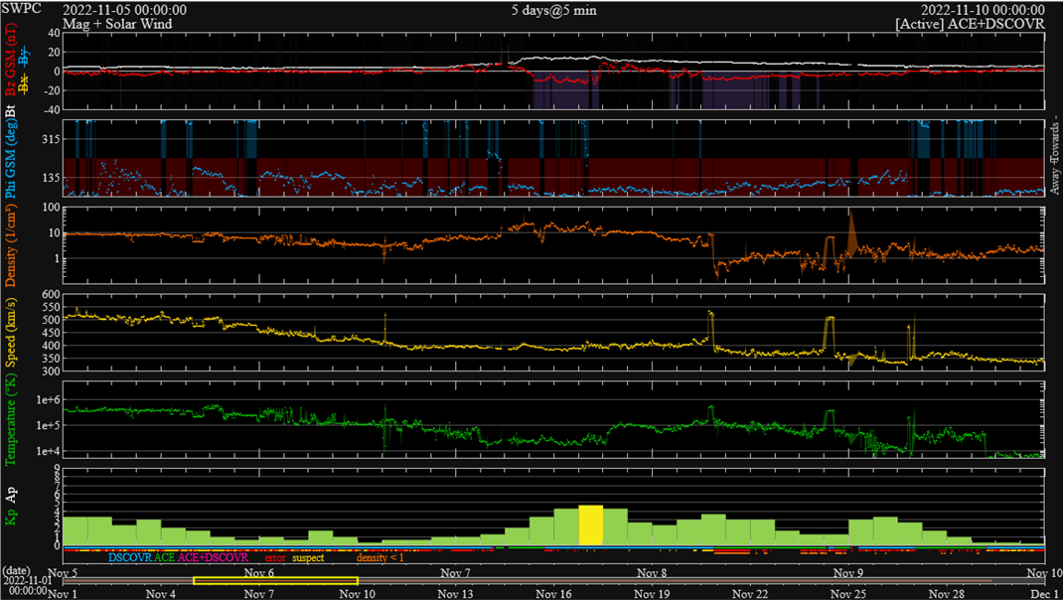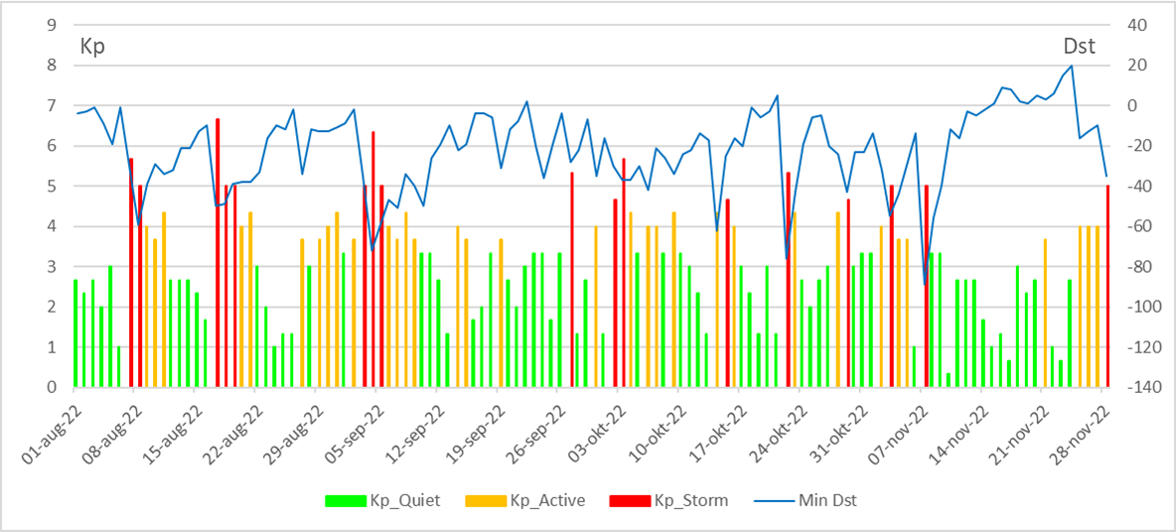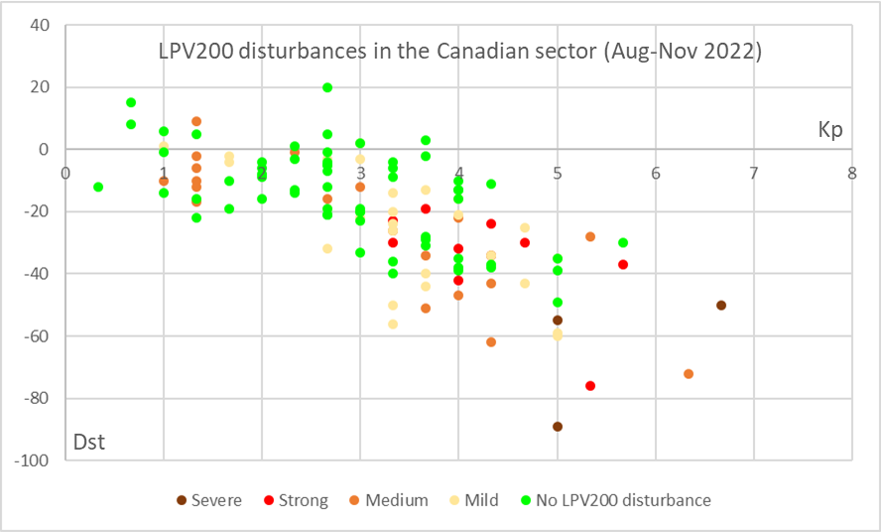On 7 November, DSCOVR registered a relatively small disturbance in the solar wind parameters. It was basically a 7-hours stretch of enhanced density, low temperature and a southward oriented magnetic field (negative Bz), as shown by respectively the orange, green and red curves underneath. The source of this "transient" is unknown. It was certainly not related to the wind stream from a coronal hole, due to the low solar wind speed (around 390 km/s and declining - yellow curve) and low temperature (green curve). Also, a sector boundary crossing (see this STCE news item) can be excluded, as the phi-angle (blue curve), which denotes the orientation of the magnetic field towards or away from the Sun, remained directed away from the Sun for the entire period, thus indicating Earth was in a positive sector all the time.

The long period of negative Bz (with values up to -14 nT) resulted in a minor geomagnetic storm during the same day. Kp reached "5-" (see the STCE SWx classification page) during the 15-18UT interval, and also the K index in Dourbes reached the value 5, but during the 18-21UT interval. Interestingly, the Dst index reached a provisional value of -89 nT, making it one the strongest storms so far this solar cycle after 4 November 2021 (-105 nT) and 14 January 2022 (-91 nT). The storm-time disturbance index Dst is designed to measure the magnetic signature of mainly the ring current in the earth's magnetosphere. Dst is computed by four geomagnetically low latitude observatories sufficiently distant from the auroral and equatorial electrojets to inhibit noise from these two sources. The values are expressed in nT and are mostly negative in case of a strong geomagnetic disturbance, as the enhanced ring current tends to counteract (weaken) the earth's magnetic field. The graph underneath shows for each day during the period 1 August - 28 November 2022 the maximum Kp index and the minimum Dst index (data from WDC Kyoto and GFZ Potsdam). Though there's a general trend that with stronger disturbances of the geomagnetic field, Kp reaches higher values and Dst becomes more negative, there's certainly not a one-on-one correspondence between the two, as they are provided by different networks that measure effects from different locations in the magnetosphere.

GNSS, the Global Navigation Satellite System, has become a household term over the last 2 decades. It refers to a fleet of satellites that transmit positioning and timing data to receivers on the ground who can then use these data to accurately determine e.g. their location. Examples of GNSS include Europe’s Galileo, the USA’s Global Positioning System (GPS), Russia’s GLONASS and China’s BeiDou. The transmitted satellite data can be disturbed in various ways, e.g. by space weather, and thus a number of systems have been developed to correct the transmitted data and improve the positional and timing accuracy. One of these "augmented" systems is called WAAS, which is short for Wide Area Augmentation System. It is based on GPS satellites and provides various services that enable aircraft to rely on GPS for all phases of flight, including precision approaches to any airport within its coverage area. Europe has a similar system called EGNOS (European Geostationary Navigation Overlay Service) which is based on Galileo satellites.
One of the WAAS services is called "LPV200", which is basically a vertically-guided landing approach aid for airplanes to as low as 200 feet (61 meters) above ground level. In the maps underneath, the availability of the LPV200 service for Canada, Alaska, and the "Contiguous US" (CONUS, aka "Lower 48") is shown on 6, 7 and 8 November. The redder, the better the LPV200 service coverage. It is evident that on 7 November, which corresponds to the day of the above-mentioned minor geomagnetic storm, the LPV200 service was significantly disturbed over large portions of Canada. No less than 82% of its area could not benefit from the full 100% of the LPV200 service, meaning that -if so required- they had to rely on back-up solutions to get the planes safely on the ground. These back-ups exist and can be used at all times, so no worries! The CONUS was significantly less affected, with only a few percent that could not rely on the full 100% LPV200 on 7 November. Similar conclusions can also be drawn for the EGNOS services over Europe, with a significant reduction in the LPV200 availability over large portions of Scandinavia on that day, and a better coverage over central and southern Europe.


For the considered period of 4 months, the LPV200 service has been severely degraded on a few other days too, notably on 17 August and 3 November when the area coverage for Canada by the LPV200 service was also below 50%. As a "quick-and-dirty" method, the 120 data points can be put together into a scatter plot, with Kp on the horizontal axis and Dst on the vertical axis. The color of each data point then indicates how much of the Canadian area was covered by a 100% LPV200 service: green is more than 99%, yellow is between 95 and 99% ("mild"), orange is between 85 and 95% ("medium"), red between 50 and 85% ("strong"), and dark brown is less than 50% ("severe"). The general trend is indeed that, over Canada, with increasing Kp and decreasing Dst, the availability of GNSS services decreases. The scatter plot also suggests that there are other contributors to deteriorated GNSS services than just geomagnetic storms, as can be gauged for example from a number of "medium" disturbances of the LPV200 during geomagnetic quiet days (Kp less than 2, and Dst higher than -20 nT). However, the space of this news item did not allow for a full-fledged case-by-case investigation of each of the data points and the possible contributors such as, for example, the effects of using local geomagnetic indices instead of the planetary Kp index, the timing and duration of the geomagnetic storm, the pre-existing conditions of the geomagnetic field, magnetosphere and ionosphere, the presence of strong solar flares or solar energetic particle events,... And that's just for the space weather portion!






